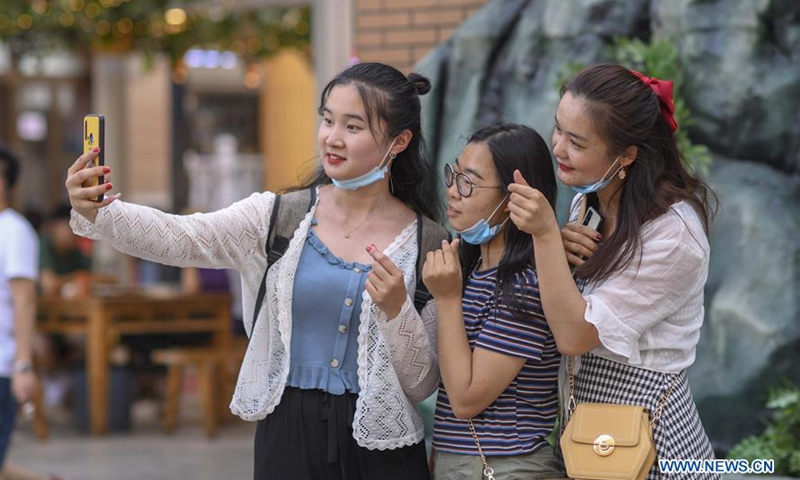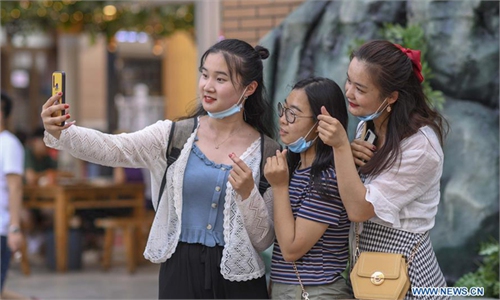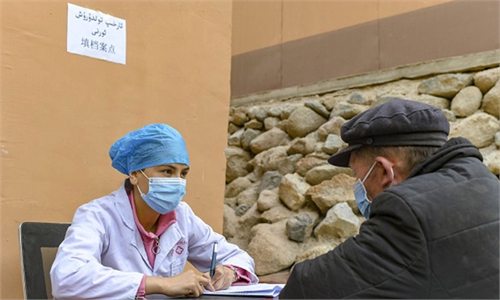Urumqi launches citywide free COVID-19 testing
Drive to cover all 3.5 million residents and people staying in hotels

Tourists pose for photos while visiting the grand bazaar in Urumqi, capital of northwest China's Xinjiang Uygur Autonomous Region, July 4, 2020. (Xinhua/Zhao Ge)
Urumqi, capital of Northwest China's Xinjiang Uygur Autonomous Region, is giving free COVID-19 tests to all 3.5 million people in the city in the wake of a new outbreak of the disease.
Unlike the citywide testing in Wuhan that was carried out after lockdown was lifted, the testing in Urumqi is intended to track the source of the community transmission, Zhang Yuexin, a medical expert who is part of the Xinjiang anti-epidemic group and also a professor of the infectious disease department of the First Affiliated Hospital of Xinjiang Medical University, told the Global Times on Tuesday.
Testing all residents will reveal how many and what kinds of people were infected in the city. There is a chance that COVID-19 long existed in Urumqi before the city reported confirmed cases and adopted any sealing-off measures to curb the virus, and in between those times, a large number of people had traveled to other cities in the region, such as Kashgar and to East China's Zhejiang Province, Zhang said.
Home to about 3.5 million people, Urumqi reported 53 confirmed COVID-19 infections and 55 asymptomatic cases as of Tuesday. The outbreak in Urumqi is linked to a group activity, but the actual origin of the cluster of infections is still unknown.
According to Xinjiang regional healthcare security administration, the cost for a nucleic acid test at a public hospital is 160 yuan ($22.89) and an antibody test ranges from 25-35 yuan.
Many Chinese cities, including Xiangtan and Zhuzhou in Central China's Hunan Province and Jiamusi in Northeast China's Heilongjiang Province, have raised their alert level over people who have traveled to Urumqi since July 1. Those people are required to report their travel histories to local communities and may have to undergo quarantine.
Urumqi's outbreak has extended to other cities - Kashgar reported one 69-year-old patient on Sunday who was originally from Urumqi, and before that, on July 16, Zhejiang Province reported one asymptomatic patient who took a flight from Urumqi on July 10.
The health authority in Urumqi said Monday that tests for members of key groups and those under medical observation have been completed. The ongoing free testing will gradually be expanded.
The free tests will also cover people currently from outside Urumqi as the local government said all hotels in the city will provide free stays, meals, pick-up services and COVID-19 tests for guests.
The testing program in Urumqi will involve 25 nucleic acid testing institutions and more than 1,600 medical workers, alongside more than 200 people in 10 nucleic acid testing medical teams from 10 provinces and cities organized by the National Health Commission.
Medical institutions are working at full capacity, with testing equipment running 24 hours a day and technicians working around the clock, the Global Times learnt.
Collection points in each of the city's districts have been set up, and the local community will reach and organize residents to be tested at designated sampling points, the Urumqi Municipal Health Commission said.
An employee from Hongqiao community located in Urumqi's Tianshan district reached by the Global Times said that thousands of residents in local communities had been tested, and sample collection work is about to be completed.
When the test results arrive, those who test positive for COVID-19 will be informed by the local community, the employee said.
The number of COVID-19 infections is showing a downward trend as the first generation of close contacts has mostly been confirmed or diagnosed as asymptomatic infections, Rui Baoling, the director of the local CDC in Urumqi, said Tuesday.
Urumqi, which is in a "wartime mode" to fight against COVID-19, has sealed all local residential communities and all gatherings are banned.
Video circulating online show the city is empty.
Urumqi's public transportation, including bus and subways as well as intercity passenger lines are suspended, but cargo transportation is operating normally.



